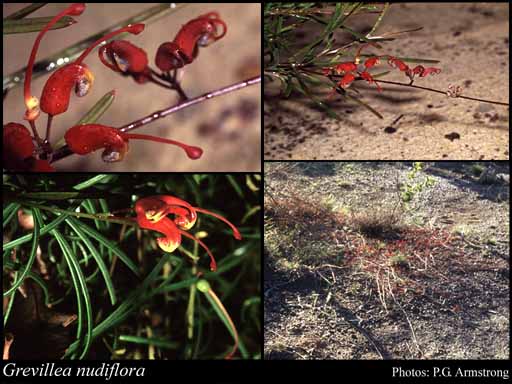- Reference
- A.DC., Prodr. 14:366 (1856)
- Conservation Code
- Not threatened
- Naturalised Status
- Native to Western Australia
- Name Status
- Current
Spreading, bushy shrub, 0.2-1.8 m high, inflorescences prostrate. Fl. red & yellow, Jan to Mar or May to Dec (mainly Jul-Nov). Sandy to loamy soils over laterite, quartzite, shale.

Scientific Description
Shrubs, 0.3 m high; branchlets hairy, not glaucous. Leaves alternate, 40-105 mm long, 1-4 mm wide, hairy or glabrous, on the adaxial or abaxial surface, the hairs straight; lamina flat, more or less the same width throughout, entire, the margins revolute, exposing the lower surface of the leaf blade or enclosing the lower surface of the leaf blade, forming a groove either side of the midvein. Inflorescences terminal, yellow, red or pink; pedicels 5-8 mm long. Perianth 7-15 mm long; tepals all free after flower opens, hairy, glandular-hairy or simple-hairy; ovary glabrous, stipitate, the stipe 1.5-2.5 mm long; pistil 18-25 mm long, red, pollen presenter lateral or oblique, style glabrous. Follicles glabrous, not viscid, dehiscent, 10-18 mm long. Flowers in July, August, September, October or November. Occurs in the South-west (SW) Botanical Province(s), in the Jarrah Forest (JF), Mallee (MAL) or Esperance Plains (ESP) IBRA subregion(s).
Distribution
- IBRA Regions
- Esperance Plains, Jarrah Forest, Mallee.
- IBRA Subregions
- Eastern Mallee, Fitzgerald, Recherche, Southern Jarrah Forest, Western Mallee.
- IMCRA Regions
- WA South Coast.
- Local Government Areas (LGAs)
- Albany, Esperance, Jerramungup, Kent, Plantagenet, Ravensthorpe.